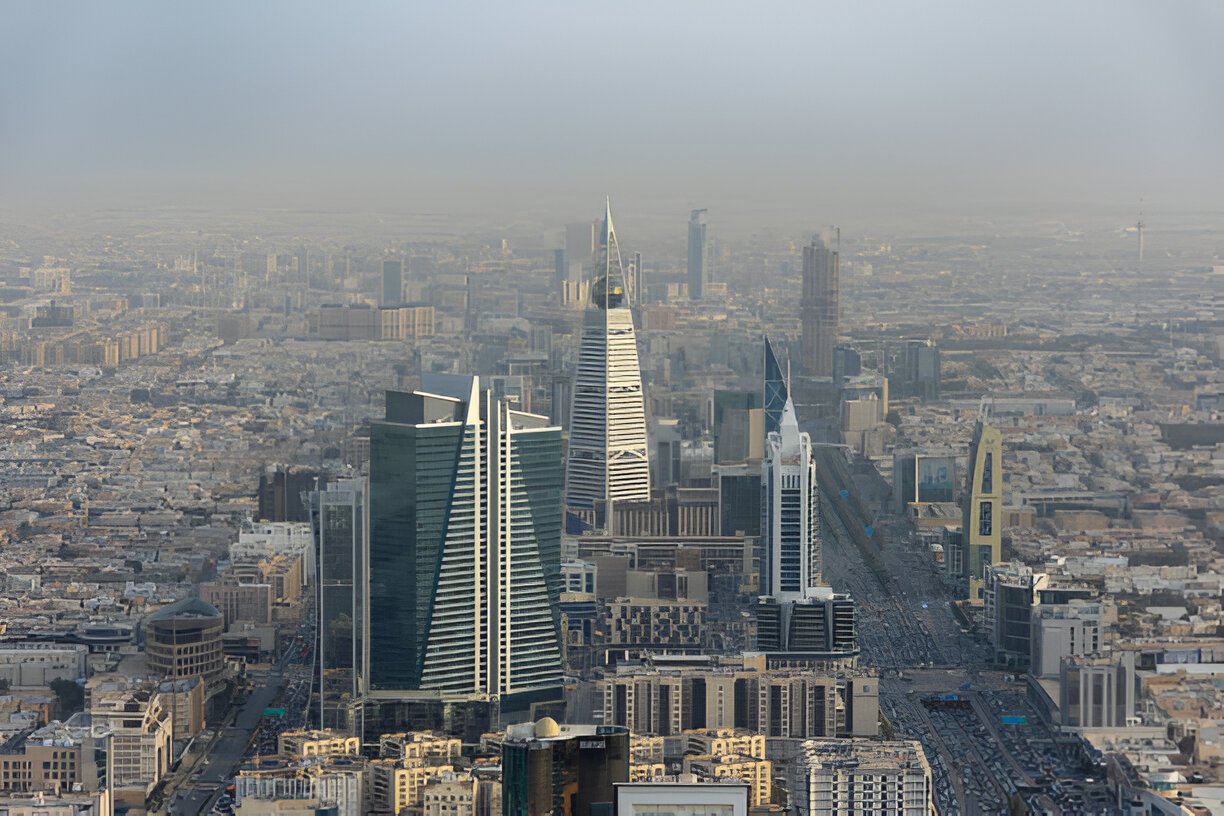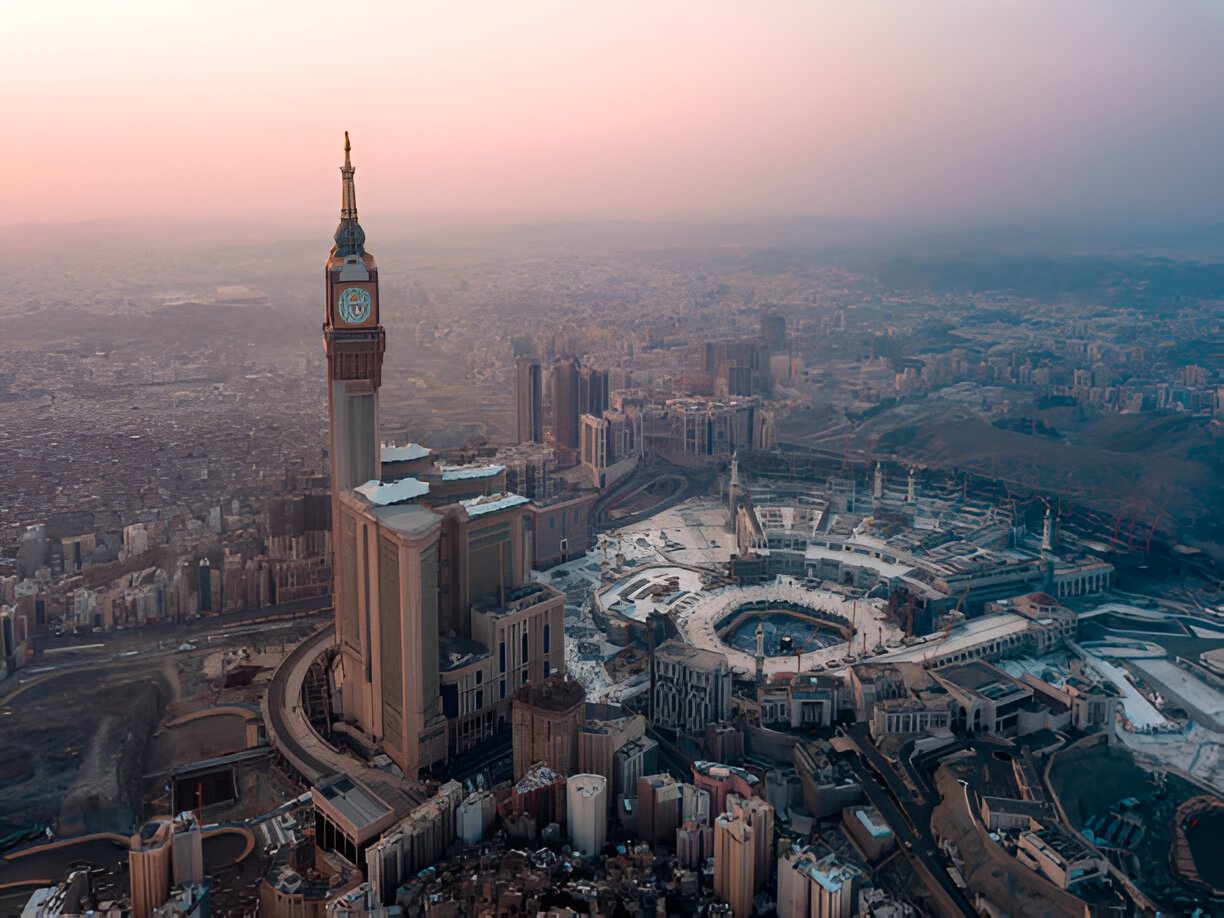What is Makkah’s development plan?
Aligned with Saudi Arabia’s Vision 2030, the goal of this development is to accommodate 30 million Umrah pilgrims by 2030 while enhancing sustainability through improved mobility and public spaces. The Masar Destination project seamlessly integrates with Makkah’s landscape and urban environment.
The development plan for Makkah is a vital part of Saudi Arabia’s Vision 2030, aiming to transform Islam’s holiest city into a modern, eco-friendly, and economically sustainable city. Its primary objective is to improve the experience for Hajj and Umrah pilgrims and to elevate Makkah’s traditional and modern significance.
Key aspects of Makkah’s development plan
Expansion of Masjid Al-Haram
- Expansion of Masjid Al-Haram (Kaaba) and its surrounding areas to increase capacity.
- Accommodation for over 2 million people to pray at the same time.
- Addition of moving walkways, air conditioning systems, and advanced security features.
Improvement of the transportation system
- The Makkah Metro Project: Rapid and convenient intra-city travel.
- Jabal Omar Project: Development of advanced road networks and underpasses to create a traffic-free environment.
- Expansion of Hajj routes: Easier connections with Jeddah and other cities.
Housing and hotel facilities
Construction of international-standard hotels and residential projects to accommodate millions of pilgrims and tourists.
Balancing between luxury and mid-range accommodations.
Environmental protection and smart city initiatives
Greening Makkah and reducing carbon emissions to make it an eco-friendly city.
Utilizing smart city technology to improve tourism, security, and IT systems.
Development of holy sites
Improved facilities at Arafat, Muzdalifah, and Mina.
Installation of air-conditioned and fire-resistant tents.
Modernized Zamzam water supply system.
Preservation of historical sites
Restoration and conservation of Makkah’s historic landmarks.
Creation of new museums and exhibition centers to showcase Islamic history and heritage.
Economic development
Strengthening Makkah’s financial base through tourism and investment.
Establishment of new commercial and economic zones.
Purpose of the plan
- Enhancing the experience of Hajj and Umrah pilgrims.
- Transforming Makkah into a world-class holy city.
- Contributing to Saudi Arabia’s economic diversification.
Through these development initiatives, Makkah will become a more modern, sustainable, and accessible city for everyone in the future.
What is the historical significance of Makkah in modern Saudi Arabia?
Makkah holds unparalleled historical significance in modern Saudi Arabia, as it is the holiest city of Islam and a symbol of spiritual unity for Muslims. Historically, Makkah has been the center of religious, cultural, and traditional values for Muslims. In the modern era, its importance has not only persisted but also increased.
Key aspects of Makkah’s historical significance:
- Makkah is the birthplace of the Prophet Muhammad (peace be upon him) in 570 CE.
- It is where the first revelation of the Quran occurred in the Cave of Hira.
- Islam began its spread from Makkah.
- The Kaaba is revered by Muslims as “Baytullah,” or the House of Allah. It i
- Islam’s first Qibla, and Muslims face it during prayers.
- According to Islamic tradition, Prophet Ibrahim (Abraham) and his son Ismail rebuilt the Kaaba.
- Hajj, one of the five pillars of Islam, is obligatory for all able Muslims at least once in their lifetime.
- Millions of Muslims gather in Makkah every year for Hajj and Umrah, symbolizing the unity of the Muslim Ummah.
- Under Saudi Vision 2030, Makkah is being transformed into a world-class modern holy city.
- The expansion of Masjid Al-Haram, development of transportation systems, and construction of eco-friendly infrastructure have further enhanced Makkah’s significance.
 What is the new plan in Makkah?
What is the new plan in Makkah?
In recent times, several development projects have been initiated in Makkah to enhance its infrastructure, transportation system, and facilities at religious sites. Notable among these is the expansion of Masjid Al-Haram, which aims to provide a more comfortable environment for pilgrims performing Hajj and Umrah.
Additionally, the Royal Commission for Makkah has focused on sustainable development, restoring and preserving historical sites, and introducing the “Discover Makkah” project to familiarize tourists with the rich history of Makkah’s landmarks.
As part of Saudi Arabia’s Vision 2030, more mega projects are being implemented in Makkah to contribute to the city’s overall development.
What is the Makkah 2030 Expansion Project?
The Makkah 2030 Expansion Project, part of Saudi Arabia’s Vision 2030, involves large-scale development and expansion to modernize and make Makkah more affordable and accessible for religious Muslims.
Goals and objectives:
- Serving 30 million Umrah pilgrims and 5 million Hajj pilgrims annually by 2030.
- Expanding Masjid Al-Haram to accommodate 2 million worshippers simultaneously.
- Introducing advanced and fast transportation systems within Makkah and its surrounding areas.
- Enhancing Makkah’s economic significance through religious tourism and creating new job opportunities.
Main projects:
- construction of new blocks in Masjid Al-Haram to increase capacity.
- Addition of new entrances, escalators, and improved air-conditioning systems.
- Modernization of the Zamzam well water supply and storage system.
- Establishment of a metro network to connect various parts of Makkah and holy sites.
- Introduction of special bus services for Hajj pilgrims.
- Construction of new roads and tunnels to reduce traffic congestion.
- Installation of air-conditioned tents in Mina.
- Expansion and modernization of Arafat and Muzdalifah areas.
- Implementation of advanced sanitation systems.
- Development of international-standard hotels and residential buildings.
- Affordable housing projects for low- and middle-income individuals.
- Preservation of Islamic historical sites and creation of new museums and
- exhibition centers for tourists.
- Use of solar energy and renewable energy sources to transform Makkah into a sustainable city.
- Tree planting and greening initiatives.
Expected outcomes:
- Improved religious tourism experience.
- Transformation of Makkah into a modern and smart city.
- Strengthened solidarity among Muslims worldwide.
- Diversification of Saudi Arabia’s economy.
 What is the Kaaba project?
What is the Kaaba project?
The project will span 19 square kilometers in northwestern Riyadh, located at the intersection of King Salman and King Khalid roads. According to the press release, it will include 104,000 residential units, 9,000 hotel rooms, over 980,000 square meters of retail space, and 1.4 million square meters of office space (February 17, 2023).
What is the new project in Makkah?
Spanning more than 1.2 million square meters and strategically located in the heart of Makkah, the Masar project will become a distinctive landmark. It will enhance the quality of life for Makkah’s residents and visitors by offering diverse services in hospitality, mobility, retail, culture, entertainment, and more.
What is the Makkah Regional Development Strategy?
The Makkah Regional Development Strategy aims to distribute development beyond the three major cities of Jeddah, Makkah, and Taif (Makkah Amanah, 2012). The Saudi government is engaged in regional planning to promote development in all 13 regions, reduce urban-rural disparities, and balance resource distribution.



